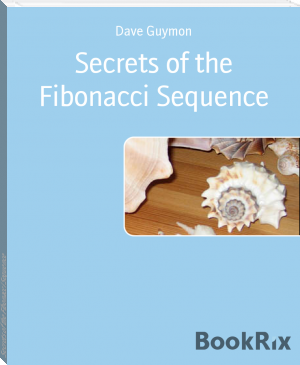Secrets of Mental Math, Arthur Benjamin [management books to read .txt] 📗

- Author: Arthur Benjamin
Book online «Secrets of Mental Math, Arthur Benjamin [management books to read .txt] 📗». Author Arthur Benjamin
Although I cannot always explain such specific occurrences, a principle of probability called the Law of Large Numbers shows that an event with a low probability of occurrence in a small number of trials has a high probability of occurrence in a large number of trials. Or, as I like to say, million-to-one odds happen 295 times a day in America.
Let’s begin with death premonitions. Here is a little “back-of-the-envelope” calculation I did. Psychologists tell us that the average person has about five dreams per day, which equals 1,825 dreams per year. Even if we remember only one out of ten dreams, that still results in 182.5 remembered dreams a year. There are 295 million Americans, so that means there will be 53.8 billion remembered dreams per year. Now, anthropologists and sociologists tell us that each of us knows about 150 people fairly well (that is, the average person has about 150 names in his or her address book about which can be said something significant). That means there is a network grid of 44.3 billion personal relationships among those 295 million Americans. The annual U.S. death rate from all causes across all ages is .008, or 2.6 million per year. It is inevitable that some of those 53.8 billion remembered dreams will be about some of these 2.6 million deaths among the 295 million Americans and their 44.3 billion relationships. It would be a miracle, in fact, if some “death premonition” dreams did not come true.
Even if my numbers are off, even way off, the point still stands. What are the odds of a death premonition dream coming true? Pretty darn good.
There is an additional psychological factor at work here called the confirmation bias, where we notice the hits and ignore the misses in support of our favorite beliefs. The confirmation bias explains how conspiracy theories work, for example. People who adhere to a particular conspiracy theory (9/11 was orchestrated by the Bush administration in order to launch a war in the Middle East), will look for and find little factoids here and there that seem to indicate that it might be true (Bush sat in that classroom reading to the children about goats as if he knew he was safe), while ignoring the vast body of evidence that points to another more likely explanation (Osama bin Laden and his band of international terrorists orchestrated 9/11). The confirmation bias also helps explain how astrologers, tarot-card readers, and psychics seem so successful at “reading” people. People who get a reading are likely to remember the handful of hits and forget the countless misses. When such hits and misses are actually counted—which I once did for an ABC television special on psychics—it turns out that there is nothing more than guessing and random chance at work.
In the case of the death-premonition dream, if just a couple of these people who have such dreams recount their miraculous tales in a public forum (next on Oprah!), the paranormal seems vindicated. In fact, it is nothing more than the laws of probability writ large.
This mathematical process of thinking about weird things led me to another back-of-the-envelope calculation about miracles. People typically invoke the term miracle to describe really unusual events, events whose odds of occurring are a “million to one.” Okay, let’s take that as our benchmark definition. A miracle is an event whose odds of occurrence are a million to one. Now, as we go about our day, we see and hear things happen about once per second. That is, data from the world and events around us are pouring in through our senses at a rate of about one per second. If we are awake and alert and out in the world for, say, eight hours a day, that means there are thirty thousand bits of data per day, or one million events per month that we take in. The vast majority of these data and events are completely meaningless, of course, and our brains are wired to filter out and forget the vast majority of them because we would be overwhelmed otherwise. But, in the course of a month, we would expect million-to-one odds to happen at least once. Add to that the confirmation bias where we will remember the most unusual events and forget all the rest, and it is inevitable that someone somewhere will report a miracle every month. And the tabloids will be there to record it!
This is a short primer on how science works. In our quest to understand how the world works, we need to determine what is real and what is not, what happens by chance and what happens because of some particular predictable cause. The problem we face is that the human brain was designed by evolution to pay attention to the really unusual events and ignore the vast body of data flowing by; as such, thinking statistically and with probabilities does not come naturally. Science, to that extent, does not come naturally. It takes some training and practice.
In addition, there are those pesky cognitive biases I mentioned, such as the confirmation bias. And there are others. The data do not just speak for themselves. Data are filtered through very subjective and biased brains. The self-serving bias, for example, dictates that we tend to see ourselves in a more positive light than others see us: national surveys show that most business people believe they are more moral than other business people, while psychologists who study moral intuition think they are more moral than other such psychologists. In one College Entrance Examination Board survey of 829,000 high school seniors, 0 percent rated themselves below average in “ability to get along with others,” while 60 percent put themselves in the top 10 percent (presumably not all were from Lake Woebegone). And according to a 1997 U.S. News & World Report study on who Americans believe are most likely to go to heaven, 52 percent said Bill Clinton, 60 percent thought Princess Diana, 65 percent chose Michael Jordan, 79 percent selected Mother Teresa, and, at 87 percent, the person most likely to go to heaven was the survey taker!
Princeton University psychology professor Emily Pronin and her colleagues tested a bias called blind spot, in which subjects recognized the existence and influence in others of eight different cognitive biases, but they failed to see those same biases in themselves. In one study on Stanford University students, when asked to compare themselves to their peers on such personal qualities as friendliness and selfishness, they predictably rated themselves higher. Even when the subjects were warned about the better-than-average bias and were asked to reevaluate their original assessments, 63 percent claimed that their initial evaluations were objective, and 13 percent even claimed that they were originally too modest! In a second study, Pronin randomly assigned subjects high or low scores on a “social intelligence” test. Unsurprisingly, those given the high marks rated the test fairer and more useful than those receiving low marks. When asked if it was possible that they had been influenced by the score on the test, subjects responded that other participants had been far more biased than they were. In a third study in which Pronin queried subjects about what method they used to assess their own and others’ biases, she found that people tend to use general theories of behavior when evaluating others, but use introspection when appraising themselves; however, in what is called the introspection illusion, people do not believe that others can be trusted to do the same. Okay for me but not for thee.
The University of California at Berkeley psychologist Frank J. Sulloway and I made a similar discovery of an attribution bias in a study we conducted on why people say they believe in God, and why they think other people believe in God. In general, most people attribute their own belief in God to such intellectual reasons as the good design and complexity of the world, whereas they attribute others’ belief in God to such emotional reasons as it is comforting, gives meaning, and that they were raised to believe. Political scientists have made a similar discovery about political attitudes, where Republicans justify their conservative attitudes with rational arguments but claim that Democrats are “bleeding-heart liberals,” and where Democrats claim that their liberal attitudes are the most rational but claim that Republicans are “heartless.”
How does science deal with such subjective biases? How do we know when a claim is bogus or real? We want to be open-minded enough to accept radical new ideas when they occasionally come along, but we don’t want to be so open-minded that our brains fall out. This problem led us at the Skeptics Society to create an educational tool called the Baloney Detection Kit, inspired by Carl Sagan’s discussion of how to detect “baloney” in his marvelous book The Demon-Haunted World. In this Baloney Detection Kit, we suggest ten questions to ask when encountering any claim that can help us decide if we are being too open-minded in accepting it or too closed-minded in rejecting it.
1. How reliable is the source of the claim? As Daniel Kevles showed so effectively in his 1999 book The Baltimore Affair, in investigating possible scientific fraud there is a boundary problem in detecting a fraudulent signal within the background noise of mistakes and sloppiness that is a normal part of the scientific process. The investigation of research notes in a laboratory affiliated with Nobel laureate David Baltimore by an independent committee established by Congress to investigate potential fraud revealed a surprising number of mistakes. But science is messier than most people realize. Baltimore was exonerated when it became clear that there was no purposeful data manipulation.
2. Does this source often make similar claims? Pseudoscientists have a habit of going well beyond the facts, so when individuals make numerous extraordinary claims, they may be more than just iconoclasts. This is a matter of quantitative scaling, since some great thinkers often go beyond the data in their creative speculations. Cornell’s Thomas Gold is notorious for his radical ideas, but he has been right often enough that other scientists listen to what he has to say. Gold proposes, for example, that oil is not a fossil fuel at all, but the by-product of a deep hot biosphere. Hardly any earth scientists I have spoken with take this thesis seriously, yet they do not consider Gold a crank. What we are looking for here is a pattern of fringe thinking that consistently ignores or distorts data.
3. Have the claims been verified by another source? Typically pseudoscientists will make statements that are unverified, or verified by a source within their own belief circle. We must ask who is checking the claims, and even who is checking the checkers. The biggest problem with the cold fusion debacle, for example, was not that scientists Stanley Pons and Martin Fleischman were wrong; it was that they announced their spectacular discovery before it was verified by other laboratories (at a press conference no less), and, worse, when cold fusion was not replicated, they continued to cling to their claim.
4. How does the claim fit with what we know about how the world works? An extraordinary claim must be placed into a larger context to see how it fits. When people claim that the pyramids and the Sphinx were built more than ten thousand years ago by an advanced race of humans, they are not presenting any context for that earlier civilization. Where are the rest of the artifacts of those people? Where are their works of art,




Comments (0)